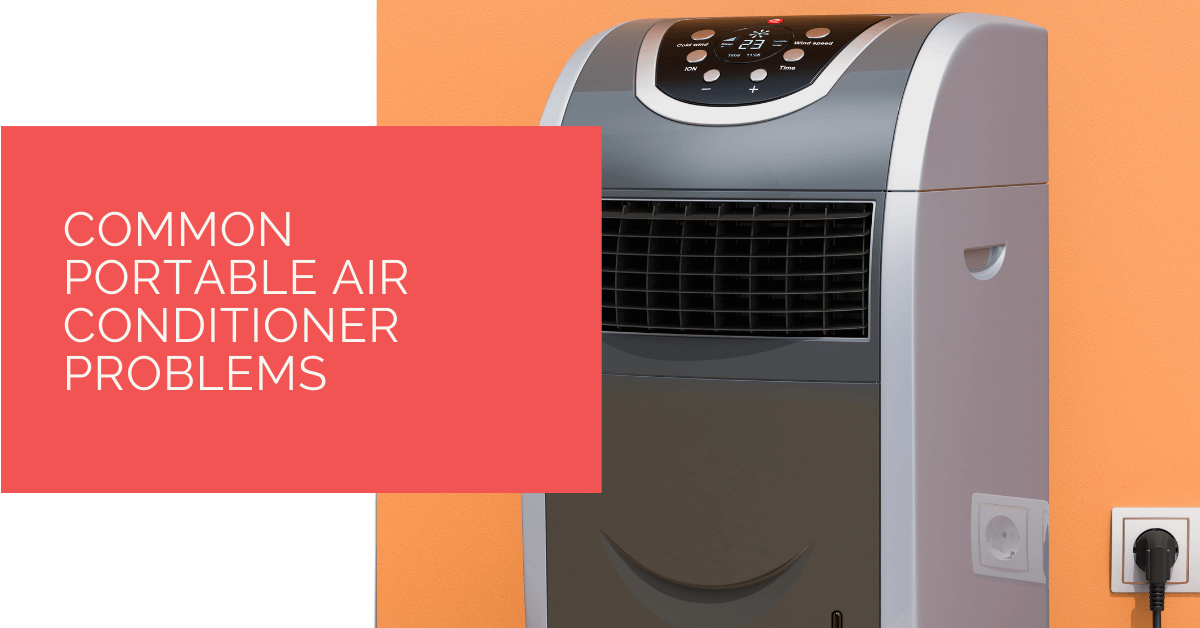Portable air conditioners have become popular for those seeking relief from the scorching heat without needing permanent installations. These versatile cooling units offer convenience and flexibility, making them ideal for cooling small spaces like bedrooms, living rooms, or offices. However, like any other appliance, portable air conditioners can encounter problems from time to time. This informative and educational article will delve into some of the most common issues portable AC owners may face and provide practical solutions for troubleshooting and improving efficiency.
Before we jump into the troubleshooting process, we must grasp the basics of how a portable air conditioner works. Understanding its components and operation can empower you to identify and resolve issues more effectively. So, let’s start with the fundamentals of portable air conditioners before tackling those common problems and offering valuable tips to keep your unit running smoothly. Whether you are a new owner or looking to enhance your DIY repair skills, this guide will help you stay cool and comfortable during the hot summer months.
Contents
Key Takeaways
- Portable air conditioners are convenient alternatives to central AC systems, but they can experience common issues that can often be resolved without professional help.
- Common problems include inadequate cooling, failure to start, lack of cool air, and issues with fan velocity, all of which may have simple solutions like cleaning filters, checking thermostats, or ensuring proper ventilation.
- Proper maintenance, including regular inspections and choosing the right BTU capacity based on room size, can help ensure portable AC units’ efficient and trouble-free operation.
Basics of Portable Air Conditioners
Before delving deep into the troubleshooting process, it is always crucial to know the basics. The technical know-how of a portable AC unit can make your job easier during a breakdown.
A portable air conditioner comprises main components like the fan, cooling coils, evaporator coil, refrigerant, compressor, and condenser. Together, these parts process warm air flowing in the room.
Here’s how this air conditioning unit combats the heat:
- The fan sucks or pulls hot air from the room
- A refrigerant circulating in the coil cools this air
- Eventually, cold air escapes the portable AC unit
Hence, the basic working principle of a portable AC is similar to any air conditioning system. However, the entire process isn’t as straightforward.
The heat transfer medium, called refrigerant, is primarily responsible for the ‘cool air escape’ process. During operation, it gains heat from warm air and needs compression.
Eventually, these ACs have an exhaust hose that vents hot air released during refrigerant compression. This fundamental understanding of portable ACs is vital to carrying out proper repair measures as a consumer.
Typical Portable AC Problems
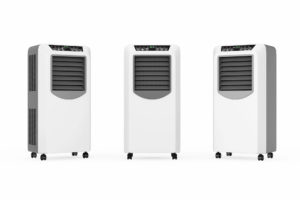 Depending on your portable AC model, there may be variations in the common issues. Still, most portable AC consumers can face most of these problems time-to-time.
Depending on your portable AC model, there may be variations in the common issues. Still, most portable AC consumers can face most of these problems time-to-time.
The AC Does Not Blow Cool Air
Do you notice that your portable air conditioner is blowing air that isn’t cold?
This issue is familiar and easy to fix. You can try multiple solutions to attain low temperatures. First, start with checking the thermostat setting. The temperature should be a notch cooler than the outside temperature for adequate airflow. It is the most accessible setting to check.
Similarly, keep an eye on your portable AC panel. Locate the ‘cool’ mode and turn it ON. Next, check the air coming out from the unit. If both these settings are optimum, it is time to clean the air filter.
Check for dust and potential contaminants that obstruct the air flow of portable AC. These solutions can rectify the airflow coming out of the AC outlet.
The Air Conditioner Does Not Start
If your air conditioner unit fails to start after switching ON, the reason might be inadequate voltage. You should check the circuit breaker and power supply outlet in such a case.
Try to connect the air conditioner to a different outlet. Next, check if the AC unit starts functioning. If you notice other electrical appliances working through the same power outlet, there is an issue with the portable AC.
If your power supply is proper, there might be an issue like a blown internal fuse. Hence, the best solution is to contact the local electrician or HVAC expert. The professional will replace the fuse and resume the regular operation of your air conditioner.
Your Portable AC Does Not Cool the Room
Another common problem with mobile air conditioners is inadequate cooling. However, this issue does not require complex portable air conditioner troubleshooting.
All you need to do is check a couple of vital factors. First, ensure that all the doors and windows are closed. The trick is to isolate the outside temperature from the room’s ambient temperature and provide supplemental cooling. By shutting the air outlets, you prevent air-flow from the exterior.
Also, it would help if you used exhaust hose outside the room for venting air properly. This solution rectifies insufficient cooling in most cases. Since air conditioner retains water, invest in a long exhaust hose for draining properly.
The AC Stops Operating
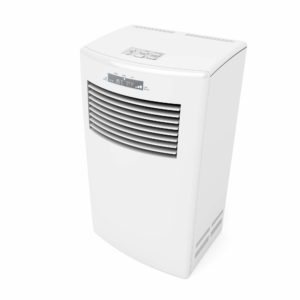 If you own some new portable air conditioner models, this problem might occur frequently. The temperature sensor or AC turns OFF after attaining the desired level of cooling.
If you own some new portable air conditioner models, this problem might occur frequently. The temperature sensor or AC turns OFF after attaining the desired level of cooling.
This function saves utility bills by preventing unnecessary power consumption. Hence, the ambient temperatures remain at a comfortable level. As soon as the room temperature increases beyond a point, the portable AC turns ON again.
So, you do not have to do anything in such a case; the air conditioner turns on and off by itself. However, if you do not want to use this feature, turn the active timer OFF (depending on your model). The AC unit will turn into a manual appliance.
Cold Air Flowing from the AC Lacks in Velocity
Even if your fan speed is in proper condition, the portable air conditioner cannot provide adequate air-flow. In such a case, you won’t enjoy enough cooling due to lack of air-flow.
There are multiple solutions to rectify this issue. First, clean the air filter using a vacuum cleaner or a handy brush. Remove any dirt, contaminants, or dust trapped in the air conditioner filter.
A refrigerant leak can be the potential cause of such an issue. Do not attempt to replace or refill the refrigerant on your own. Contact a trained portable air conditioner expert in such a case.
Finally, frost buildup on evaporator coils can hamper swift air-flow. Using the’ defrost’ function if your portable air conditioner supports the mechanism. This feature is, however, present in many modern portable ACs. Else call a mechanic to defrost the evaporator coil.
The Weather is Too Hot
Some air conditioner problems are non-technical. For instance, a heatwave or extreme ambient temperatures can impact your gadget’s utility.
However, you can keep the unit cool by following specific steps. If your room is located under direct sunlight, it is time to invest in curtains and proper insulation. This results in a reduction of heat load on the air conditioner unit, which can vent hot air.
The ambient temperature of your room can remain cool with an adequately large air conditioner. Hence, before buying a portable AC, be sure to calculate the square footage of your rooms. Consequently, the retailer will suggest an air conditioner with sufficient capacity.
In addition, living rooms with several electronic devices can generate heat. So, a small air conditioner can prove inadequate to combat heat generated by this equipment.
Musty Smell
An air conditioner is the ideal breeding ground for mould, bacteria, and mildew growth. These units retain water, thereby leading to a filled condensate tank.
Along with supplemental cooling, the condensate tank must drain appropriately with the help of a dedicated hose. A hindrance to this process leads to a musty odour, prominent in many portable air conditioner units. Check the drain line to ensure that the water can drain properly.
In such a case, you need to empty the condensate tank. There are three ways to open the portable AC tank:
- Use a pan to collect water manually
- Utilize an exhaust hose arrangement
- Attach a condensate pump
All three methods are efficient to remove water from your portable air conditioner. So, the musty smell won’t stay after this process.
The Portable Air Conditioner Does Not Stop
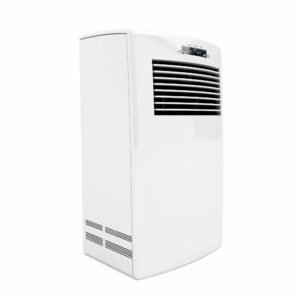 As soon as the air conditioner switches ON, other components like timers sensors begin functioning. It leads to the temporary shutting of the unit after attaining the set temperature.
As soon as the air conditioner switches ON, other components like timers sensors begin functioning. It leads to the temporary shutting of the unit after attaining the set temperature.
Still, some portable ACs do not turn OFF. This issue arises due to the malfunctioning of the sensor. The fault can be in the relay or control board unit in some cases. So, is there a DIY solution?
Unfortunately, no. You can try switching to other air conditioner modes and find a temporary solution. However, contacting a trained electrician is your best option to rectify such electronic problems. Not every malfunction has a DIY solution. Hence, reading the user manual and having a reliable appliance repairer proves handy on such occasions.
How to Improve Portable Air Conditioner Efficiency?
With some routine tips, you can avoid problems like an overheated compressor, malfunctioning fan motor, or inadequate cooling. This section explains helpful tips in brief.
Proper Configuration of Air Vent Hose
In addition to ambient temperature adjustment, you should pay attention to the essential components. Correct positioning of the air vent hose improves the ‘cooling’ performance of your AC.
You need to ensure that the air vent hose is long and directed outside. Also, the hose should remain as straight as possible to avoid damage due to unnecessary twists.
You can also buy a power cord of sufficient length to place the portable AC unit and hose properly.
Invest in Insulation of Windows
Windows are essential for adequate ventilation of the room. However, if the outside temperature is too hot, you should keep them closed. Consequently, the portable air conditioner will function adequately due to decreased heat load.
Investing in a double glazed glass, air seal, or reflective film will prove beneficial in many ways. Also, you won’t need to worry about the halt in AC functioning during a power failure as heat transfer from outside remains under control.
Finally, try to prevent direct sunlight from entering the room. You will notice a direct impact on the portable air conditioner efficiency.
Regular Inspection
Last but not least, try to inspect components like evaporator coils, air filter, hose, and condensate tank. A clogged filter can be a common cause of many routine AC issues.
Also, a regular visual check can prevent problems like a blown compressor. Be sure to install a circuit breaker, which is vital for portable units similar to centralised air conditioners. This way, your portable unit will maintain its cooling capacity and function properly to keep the air dry as per requirement.
Remember, the evaporator coil, condenser coils, compressor, and vent hose need a periodic inspection. Significantly, this process does not consume much of your time.
Choose the Right Size Portable AC to Combat Hot Air
You can carry out all the maintenance activities but still face the issue of insufficient cooling. The reason for this is simple. The portable unit is just too small for your room.
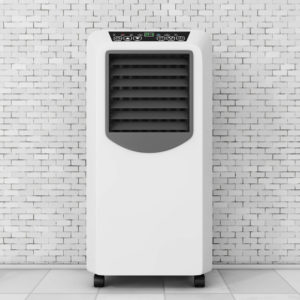 Hence, choosing a suitable capacity portable AC is vital to get adequate cooling with controlled power consumption. To get started, you should know a bit about BTU (British Thermal Unit), which is measured per hour in most cases. BTU/h means the rate of heating or cooling that can be transferred or extracted by HVAC devices.
Hence, choosing a suitable capacity portable AC is vital to get adequate cooling with controlled power consumption. To get started, you should know a bit about BTU (British Thermal Unit), which is measured per hour in most cases. BTU/h means the rate of heating or cooling that can be transferred or extracted by HVAC devices.
Generally, it would help to calculate your room’s BTU rating per square foot. For ACs, 20 BTU per square foot is a standard estimate. However, you need to make adjustments for actual capacity calculation.
- Multiply the length and width of your desired room
- If your room is under sufficient shade, reduce 10% BTU capacity
- On the other hand, if your room is under sunlight, increase the capacity by 10%
- Also, the BTU capacity increases based on the number of occupants
- If you plan to keep your portable AC in the kitchen, you will need a high-capacity AC
A reliable portable AC unit brand has well-defined calculations for choosing a suitable capacity. Still, the above method can give you a rough estimate of the model you should look for.
Overall, you can enjoy optimum cooling with an adequate BTU/h rated portable AC based on your room’s area.
Heat Pump Source: Reliable Heating and Cooling Solutions
At Heat Pump Source, we take pride in our unwavering commitment to serving the UK with top-tier HVAC solutions. From the efficiency of heat pumps and the cool relief of air conditioning to the warmth of boilers, radiators, and underfloor heating, our dedicated team is always at the forefront of innovation. We understand the unique needs of every household and business, and we strive to provide dependable health and cooling products and services that are tailored just for you. Ensuring your comfort and satisfaction is our utmost priority. Whether you have questions, need guidance, or require support, we’re always here to assist. Please don’t hesitate to contact us; we’re eager to be of service.
Wrapping Up
Most of the typical portable AC unit problems are easy to solve. Basic knowledge about the components and working of these units make the troubleshooting process a tad easier.
However, it is beneficial to perform regular inspections and maintenance of such electric gadgets. Consequently, you will minimize most of the common problems. To get the best cooling experience, buy a unit with a suitable BTU rating. Notably, it would help if you didn’t end up purchasing a too small or big unit.
These are ideal for cooling small areas, such as bedrooms or living rooms, or providing additional cooling in places central AC systems can’t reach.
Now that you know the essential fixes to standard portable AC units, it is time to become a DIY repairer. After all, you can avoid contacting the professional frequently after buying a portable AC.
About the Author
At Heat Pump Source, our articles are the product of a collaborative effort among a team of highly skilled HVAC experts. Our dedicated professionals, hailing from diverse backgrounds in heating, ventilation, air conditioning, and refrigeration, contribute their extensive knowledge and experience to every piece of content. This multidisciplinary approach ensures comprehensive coverage. Our commitment is to deliver authoritative, reliable, and tailored advice to meet the unique needs of every household and business across the UK.

